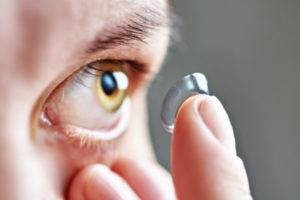February 1, 2023
By Dwight Akerman, OD, MBA, FAAO, FBCLA, FIACLE
 Among the interventions currently available to manage childhood myopia, low-concentration atropine, novel spectacle designs, orthokeratology contact lenses, dual-focus contact lenses, and extended depth of focus multifocal contact lenses have exhibited reasonable success in slowing the progression of myopia.
Among the interventions currently available to manage childhood myopia, low-concentration atropine, novel spectacle designs, orthokeratology contact lenses, dual-focus contact lenses, and extended depth of focus multifocal contact lenses have exhibited reasonable success in slowing the progression of myopia.
Combination therapy is a logical and systematic approach to improving the patient experience and/or efficacy obtained with monotherapy alone. Therefore, researchers and clinicians are increasingly exploring combination therapy. Examples of combination therapy for myopia management include:
- myopia control soft lenses combined with topical low-dose atropine
- orthokeratology combined with topical low-dose atropine
- novel myopia control spectacles combined with topical low-dose atropine
- myopia control soft lenses combined with increased outdoor time
Erdinest et al. aimed to assess the decrease in myopia progression and rebound effect using topical low-dose atropine compared to combined treatment with contact lenses for myopic management. This retrospective review study included 85 children aged 10.34 ± 2.27 (range 6 to 15.5) who were followed over three years. All had a minimum myopia increase of 1.00D the year prior to treatment. The children were divided into two treatment groups and a control group. One treatment group included 29 children with an average prescription of 4.81 ± 2.12D (SE), treated with 0.01% atropine for two years (A0.01%). The second group included 26 children with an average prescription of 4.14 ± 1.35D (SE) treated with MiSight 1 day dual focus contact lenses (DFCL) and 0.01% atropine (A0.01% + DFCL) for two years. The control group included 30 children wearing single-vision spectacles (SV), averaging -5.06 ± 1.77D (SE).
There was an increase in the SE myopia progression in the SV group of 1.19 ± 0.43D, 1.25 ± 0.52D, and 1.13 ± 0.36D in the first, second, and third years, respectively. The myopia progression in the A0.01% group was 0.44 ± 0.21D (p < 0.01) and 0.51 ± 0.39D (p < 0.01) in the first and second years, respectively. In the A0.01% + DFCL group, the myopia progression increased by 0.35 ± 0.26D and 0.44 ± 0.40D in the first and second years, respectively (p < 0.01). The total progression over the three years in the SV group was 3.57D (average 1.19 ± 0.43D annually), in the A0.01% group 1.196D, and in the A0.01% + DFCL group 0.96D.
This study demonstrated the effectiveness of atropine therapy as a standalone treatment and combined with peripheral defocus lenses and the low rebound effect when atropine is tapered following treatment.
The researchers concluded that monotherapy low-dose atropine, combined with peripheral blur contact lenses, was clinically effective in decreasing myopia progression. In this retrospective study, combination therapy did not present an advantage over low-dose atropine monotherapy.
Abstract
Low-Concentration Atropine Monotherapy vs. Combined with MiSight 1 Day Contact Lenses for Myopia Management
Nir Erdinest, Naomi London, Itay Lavy, David Landau, Dror Ben Ephraim Noyman, Nadav Levinger, Yair Morad
Objectives: To assess the decrease in myopia progression and rebound effect using topical low-dose atropine compared to combined treatment with contact lenses for myopic control.
Methods: This retrospective review study included 85 children aged 10.34 ± 2.27 (range 6 to 15.5) who were followed over three years. All had a minimum myopia increase of 1.00 D the year prior to treatment. The children were divided into two treatment groups and a control group. One treatment group included 29 children with an average prescription of 4.81 ± 2.12 D (sphere equivalent (SE) range of 1.25-10.87 D), treated with 0.01% atropine for two years (A0.01%). The second group included 26 children with an average prescription of 4.14 ± 1.35 D (SE range of 1.625-6.00 D), treated with MiSight 1 day dual focus contact lenses (DFCL) and 0.01% atropine (A0.01% + DFCL) for two years. The control group included 30 children wearing single-vision spectacles (SV), averaging -5.06 ± 1.77 D (SE) range 2.37-8.87 D).
Results: There was an increase in the SE myopia progression in the SV group of 1.19 ± 0.43 D, 1.25 ± 0.52 D, and 1.13 ± 0.36 D in the first, second, and third years, respectively. Myopia progression in the A0.01% group was 0.44 ± 0.21 D (p < 0.01) and 0.51 ± 0.39 D (p < 0.01) in the first and second years, respectively. In the A0.01% + DFCL group, myopia progression was 0.35 ± 0.26 D and 0.44 ± 0.40 D in the first and second years, respectively (p < 0.01). Half a year after the cessation of the atropine treatment, myopia progression (rebound effect) was measured at -0.241 ± 0.35 D and -0.178 ± 0.34 D in the A0.01% and A0.01% + DFCL groups, respectively.
Conclusions: Monotherapy low-dose atropine, combined with peripheral blur contact lenses, was clinically effective in decreasing myopia progression. A low rebound effect was found after the therapy cessation. In this retrospective study, combination therapy did not present an advantage over monotherapy.
Erdinest, N., London, N., Lavy, I., Landau, D., Ben Ephraim Noyman, D., Levinger, N., & Morad, Y. (2022). Low-Concentration Atropine Monotherapy vs. Combined with MiSight 1 Day Contact Lenses for Myopia Management. Vision, 6(4), 73.
DOI: https://10.3390/vision6040073













